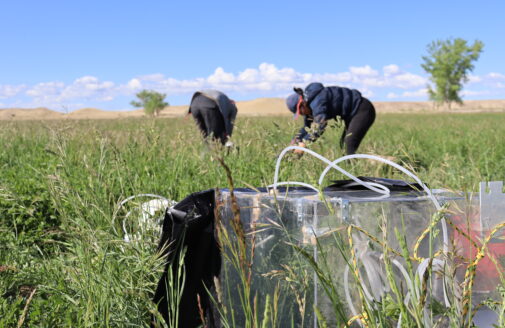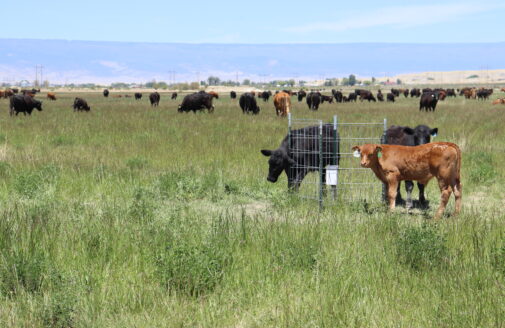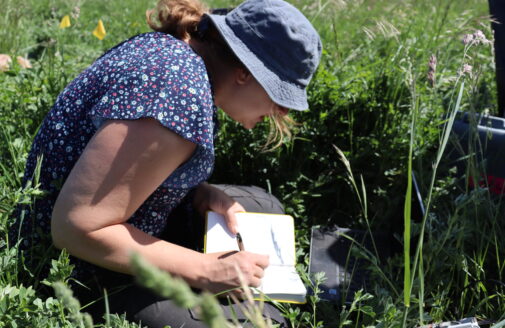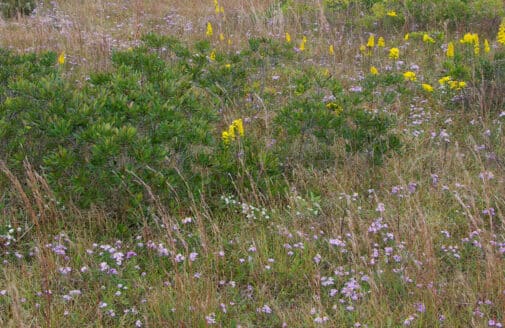Climate scientists and cattle ranchers meet at High Lonesome Ranch
Regenerative ranching workshop explores the ways cattle ranchers can contribute to climate solutions
Jon Sanderman leading a group discussion from a soil pit during the workshop field tour.
photo by Andrew Mullen
High Lonesome is a working cattle ranch that does things a little differently. The managers of High Lonesome employ regenerative ranching, a technique that works with natural cycles and ecological principles to restore a degraded landscape. The result is a productive ranch with healthy cows, good water retention, a diverse ecology, and—crucially for our work—carbon-rich soils. It’s an ideal location for Woodwell Climate Research Center’s second annual Rangeland Carbon Workshop.
On a beautiful late September day in western Colorado, the Woodwell Climate Rangeland Team (myself, Dr. Jon Sanderman, Dr. Yushu Xia, and Andrew Mullen) gathered at High Lonesome Ranch to lead the workshop in partnership with Colorado State University and Green Groups Graze. We were joined by 45 scientists, ranch managers, members of NGO communities, and representatives from government agencies, all eager to discuss rangeland health, management, and monitoring in the U.S.
Sunset at High Lonesome Ranch—all quiet except for the not-so-distant call of coyotes.
photo by Andrew Mullen
Conversations centered on the benefits and challenges of regenerative practices like the ones used at High Lonesome. One core tenet of regenerative ranching is the use of adaptive grazing systems—a concept that promotes the frequent movement of livestock between pastures (whether that’s cattle, bison, goats, or another grazing animal) with short, intense, grazing intervals. Following a grazing event, that land is given a long period of rest and regrowth. These cycles between grazing and rest help promote robust, healthy plant communities with deep root systems. They also keep nutrients cycling through the system, building up a store of water and soil carbon over time.
The growing interest in regenerative ranching across the U.S. (and globally) is being driven by the awareness of increasing impacts from climate change. Severe droughts, flooding, and fire have posed a particular threat to ranching communities. In July 2020 the historic Pine Gulch fire burned through a large portion of High Lonesome Ranch, as well as their grazing leases on adjacent U.S. land. The fire destroyed $1 million in ranching infrastructure and much of the forage needed for grazing that year. It also caused undesirably dense shrubs to replace diverse herbaceous plant species.
On top of climate-driven changes, many ranches in the area are simultaneously dealing with the after-effects of land degradation, lost plant cover, and depletion of soil carbon following decades-to-centuries of misuse. But because ranching communities directly rely on healthy lands for their socioeconomic well-being, many members of these communities are coming forward as good stewards, with the goal of improving private and public lands for the benefit of their families, their country, and future generations.
Throughout the workshop we heard from multiple producers about how they are continuously adapting and evolving their land management practices, building up an arsenal of regenerative strategies by combining their knowledge of ecological principles with what they are observing first hand on the land.
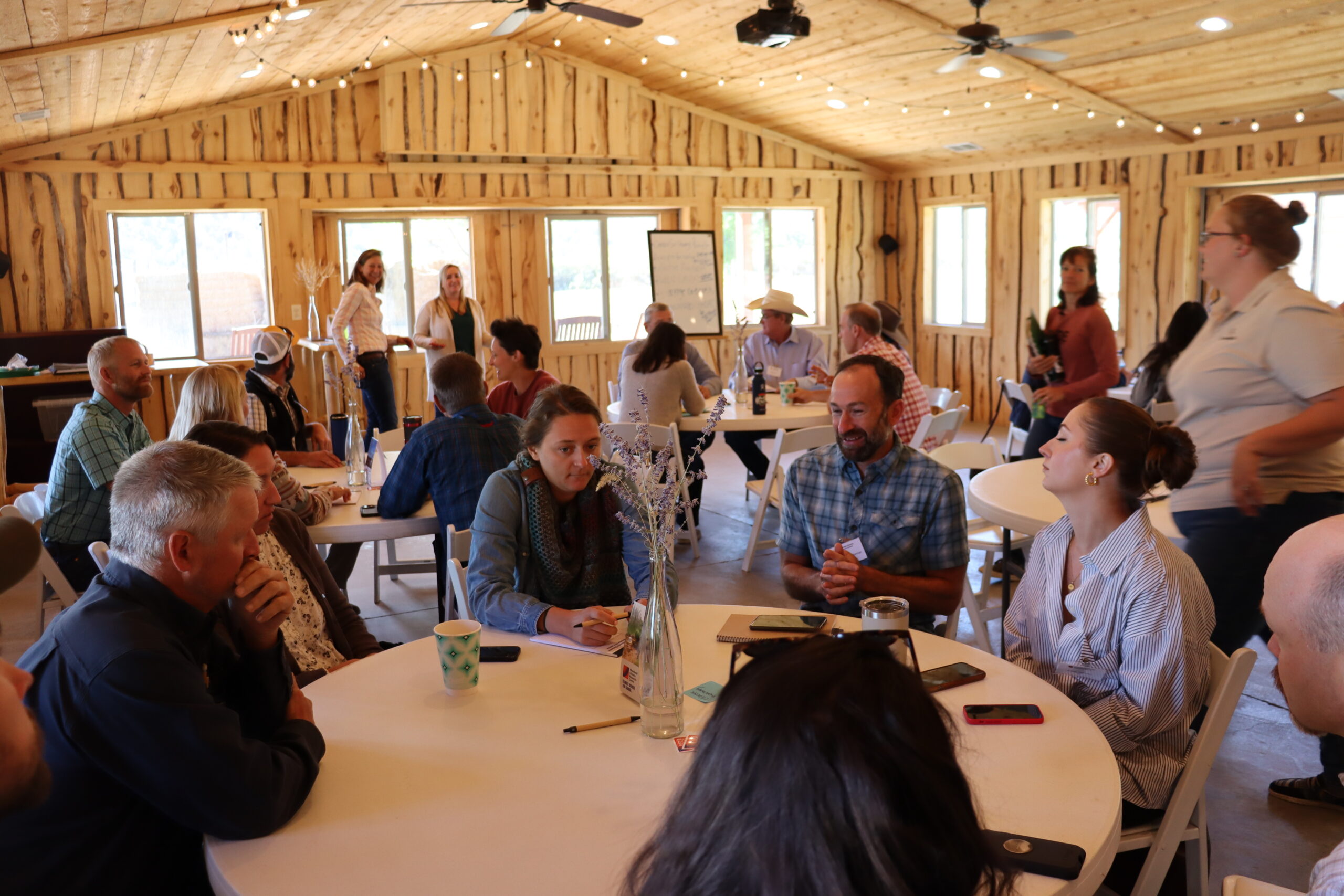
Group breakout discussions centered around multiple topics, including community-based monitoring of changes in range health, and emerging opportunities like solar farms on private and public rangelands.
photo by Andrew Mullen
In response to the Pine Gulch Fire, High Lonesome ranch is now adapting by bringing in alternative livestock (goats) to browse down the shrubs, helping to create more structurally and ecologically diverse ecosystems. They are also exploring new methods of sustainable fencing, including a virtual fencing approach where ranchers use GPS-enabled devices that electronically encourage animals to stay within designated grazing areas.
We also discussed how we define the “health” of rangelands in the first place, and how to monitor changes in ecosystem health indicators over time. The importance of monitoring ecosystem health across all U.S. rangelands recently came to the forefront after the bipartisan organization Public Employees for Environmental Responsibility (PEER) released a report in late 2022, based on data from Bureau of Land Management (BLM) monitoring sites on western lands. The report revealed severe declines in the “health, diversity, and productivity” of public grazing lands, primarily driven by overgrazing. The report also emphasized a need to improve data collection and mapping efforts to track range health, while restoring ecosystems through improved management.
Ferdinand the pet bull.
photo by Andrew Mullen
But getting to “improved management” and “healthy rangelands” means filling in information gaps. Our conversations revealed the difference between the kinds of information producers find important in making management decisions, and what information researchers and conservation groups might want to use to understand healthy rangelands.
“Producers need information on the health and vigor of the vegetation in order to make day-to-day management decisions, while conservation groups may be more interested in the broader ecosystem service benefits, such as bird biodiversity and carbon storage, that are emerging from good rangeland stewardship,” says Sanderman.
Our discussions at High Lonesome indicated a need for a “well-designed, sustainable, wall-to-wall” land health monitoring system for public and private lands alike—something that could integrate producer knowledge with repeated point-based field observations and data provided through remote sensing. A tool like this could help ranchers make decisions that build up carbon storage and provide the ecosystem services that conservation groups are hoping to restore, while also keeping their businesses productive.
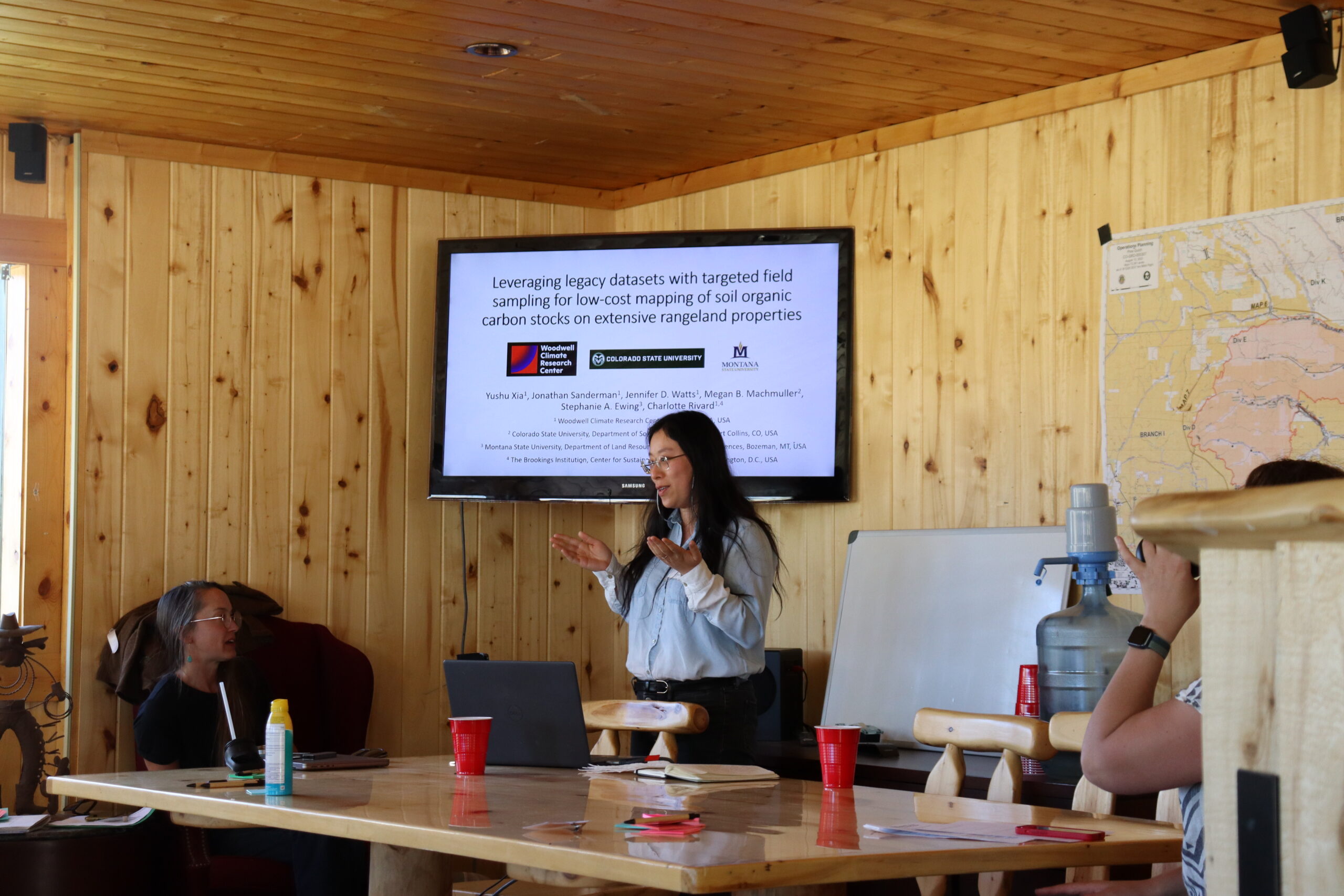
Yushu Xia presents on best methods for targeted soil sampling.
photo by Andrew Mullen
As part of her postdoctoral position, Xia has been constructing a tool to fill this need, aiding ranchers’ decision making around regenerative ranching practices.
“We’ve been working on developing the first version of the Rangeland Carbon Monitoring Tool (RCMT) system, which provides high resolution estimates of rangeland soil carbon and productivity,” says Xia. “This workshop presented a valuable opportunity for us to gather insights from diverse stakeholders. Their inputs are crucial for us to improve the visualization of our tool.”
Being able to empirically show improvements in carbon storage on rangelands could also help ranchers benefit economically from soil carbon markets—a still-developing strategy for including rangelands in natural climate solutions.
“While there are a lot of debates regarding the practicality of implementing improved rangeland management for economic gains in the carbon market, there is a consensus on the necessity of improved quantification tools like the RCMT,” says Xia. “These tools are essential to reduce the uncertainty of soil carbon estimates, and thereby facilitate improved rangeland management for multiple ecological benefits.”
Throughout the workshop it also became clear that, in addition to a need for new tools like the RCMT, ranchers need more access to programs that offer community-based networking and knowledge sharing of regenerative practices, as well as support for improving ranch infrastructure to better enact regenerative agriculture. Ultimately, ranchers would also benefit greatly from programs that provide financial payments for ecosystem services provided by healthy open spaces—a model that would allow them to prioritize biodiversity, wildlife habitat, and carbon sequestration in their decision making. Achieving these goals will require changes in programs and policies at all levels, from local to federal, to provide a much-needed investment in the well-being of our rural environments and the health of our planet.




